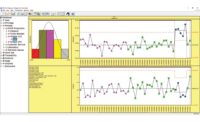Statistical process control (SPC), Six Sigma, process capability and Cpk are counterintuitive and complex concepts. Well-meaning people may show a chart to a customer thinking that it is terrific when, in reality, it is worthless. It takes formal training, practice and testing to fully appreciate the nuances, limitations and potential of these statistical and probabilistic methods and concepts.
Terminal block manufacturing is a statistician's dream. One method to make this dream come true is to use variable control charts, particularly of the X and R type and process capabilities of the Cpk and Ppk type, to monitor long streams of data.
It may look bad, but it's good
The X and R chart in Figure 1 shows depths. Each point on the X chart is the average of six measurements. This chart's upper control limit (UCL) and lower control limit (LCL) were calculated using the mean plus or minus the average range multiplied by the A2 factor (0.48 or 0.483) for subgroups of six. Each point on the R chart is the range of those six measurements.
This chart's UCL was calculated using the average range multiplied by the D4 factor (2.00 or 2.004) for subgroups of six. These are typical Shewhart charts with three sigma control limits developed during a defined control period. Thus, if the control trends are maintained, it would be expected that 99.7% of the recorded points would be within the control limits.
The obvious stands out in Figure 1. What looks like cyclic behavior and loss of control can be seen. The operator and engineer monitoring this would be expected to adjust the process and look for attributable causes.
The X chart shows 19 points and two runs above the UCL indicating that the process is running too high and needs adjustment downward. It also shows four points below the LCL, indicating that the process average is too low and requires adjustment upward. Something has changed since these limits were developed and some attributable causes may need to be corrected. The process average seems to have shifted for extended periods of time.
The R chart shows points above the UCL indicating that there is more variation in the process than when the limits were developed. One could state that the process is often out of control. The R chart has many low points that indicate little or normal variation. This is good unless the measurements are in error and are masking a problem.
From these observations, operators would be expected to make adjustments to the process. If this chart was designed correctly under conditions of control and normal process capability, then it is a useful chart showing out-of-control conditions that must be corrected.
Some observations include Type I and Type II errors. Type I errors are when it is stated that good things are bad. Type II errors are when it is stated that bad things are good. Type I and II errors obscure the truth. When it is stated that good things are good or bad things are bad, both cases are correct and the truth is known.
Even when stated, it is still not known if the product had to be scrapped or reworked. One cannot tell because the process capability is not shown on X and R charts. If this were a capable process, virtually no product would be out of specification, and conversely, if this were an incapable process, even in-control product may not be satisfactory.
It looks good, but is it very good?
Figure 2 shows what appears to be a functioning and useful X and R chart used in height control. The 30 points of subgroup size six appear to be normally distributed within the control limits. More points are near the centerline and less are near the control limits. One point in the X chart is slightly above the UCL. There is an apparent cyclic behavior in the process average because of a typical method of operation. This was accepted during the chart control limit development run.
Having seen this functional chart, a customer, auditing a vendor's SPC of some critical parameters, may ask if this process was capable. Then again, maybe the customer will not ask. The customer may be a statistical control expert who knows the specifications and can infer the capability without talking about it.
The customer may ask to see how the process capability of this process is monitored. It is wise to know that the Pp and Cp process capability is the ratio of the specification's range divided by the variation of the process. This is a measure of spread only. Ppk and Cpk process capability ratios take into account the process mean's difference from the upper or lower specification all divided by the process variation. This is a measure of spread and of centering.
It is worthwhile to list the formulas:
Pp=(USL-LSL)/(6 x Sigma)
Cp=(USL-LSL)/(6 x Sigma Est)
Ppk= minimum of USL- X or LSL- X/(3 x Sigma)
Cpk = minimum of USL- X or LSL- X / (3 x Sigma Est)
Sigma is the standard deviation of the data stream during that period.
Sigma Est is the estimate of the standard deviation calculated from R/d2.
Pp and Ppk are often referred to as long-term process capability.
Cp and Cpk are often referred to as short-term process capability.
Pp and Cp are useful for evaluating process potential.
Ppk and Cpk are useful for evaluating process performance.
Customers will often request that suppliers monitor both Cpk and Ppk. They will also ask for Cpk to perform at a higher numerical value than Ppk. For example, the customer may say that a Ppk of 1.67 and a Cpk of 2 are required. This is a thought-out tactic taking into account that processes go out of control and process averages shift and stay that way for extended periods of time.
Figures 3 and 4 are taken from the same data as Figure 2. In fact, they are the same data presented in a different format. Although they look almost identical, the process capabilities are numerically different as are the calculated probabilities of being outside of the specifications. These capabilities can be shown like this:
Ppk = 0.713 Pp = 0.751
Sigma = 0.044
Probability outside = 2.40%
Cpk = 0.848 Cp = 0.902
Sigma = 0.037
Probability outside = 0.75%
The use of sigma estimated from R tends to overestimate the process capability and underestimate the probability out of specification. These differences can be dramatic under certain out-of-control conditions.
The customer would conclude that this process is marginal or not capable and points that are out of, or near, the control limits would probably result in defective product. As such, the chart in Figure 2 is not a preventive method. Scrap and defectives are not prevented.
A good X and R SPC chart is one that prevents defective parts from being manufactured. The X control limits of 9.44 and 9.35 in this case were not sufficiently within the specification limits of 9.50 and 9.30 to do this. The Ppk and Cpk that are less than one indicate this situation. Standard deviation in subgroup means is related to the standard deviations of individuals by the root of the subgroup size. To account for this, Shewhart developed his chart factors so that the control limits on X and R charts become tighter as subgroup sizes get larger.
Looks good, but is it?
X charts such as the one in Figure 5 may look good, but the chart is worthless. A statistical process control chart is supposed to control. This chart is not controlling; it is recording data between outdated control limits.
A normal randomness should be expected. But, the process has changed. The change could be caused by the machine, the man, the material, the method or the measurement instruments. The control limits may need to be recalculated. Even if this chart is correctly centered on the specifications, it is still considered to be a poor or bad chart.
A correctly designed and functioning X chart should have:
68.3% of its points within ± one sigma
95.6% of its points within ± two sigma
97.3% of its points within ± three sigma (UCL & LCL)
Figure 5's R chart's apparent nonrandomness may be cause for alarm. In this case the nonrandomness is caused by instrument resolution and is of concern to quality.
The truth is ugly
Figure 6 is a process capability chart that shows how incapable this process is. The Pp of 0.489 indicates that the inherent randomness of this process is inadequate to meet the 18 ± 1.5 specifications. At best, this would lead to 14% out-of-specification process. The Ppk of 0.289 indicates that the process is too variable for these specifications and is also centered. Its mean is at 18.6 and the specification is 18. Depending on the process, the centering could be easy, difficult or impossible to adjust.
The actual situation predicts that 19.2 % of the production is above specification and 1.9% would be below specification. The Cp and Cpk charts were almost identical in values and they are not shown here. The X chart in Figure 5 did not stand up to normal scrutiny.
Making good out of the bad and ugly
Figures 5 and 8 show that a process was incorrectly charted and incapable of meeting the specifications. In the short term, the X and R chart could be re-engineered so that its control limits reflect the actual process and not some past situation.
To do this, first, recalculate the control limits using the same raw data that is in Figures 5 and 6.
Figure 7, the new chart, now shows a now functional X chart with points distributed more normally within the control limits. There is some apparent cyclic behavior that has been attributed to changes in production lots. These are considered typical and are a part of the inherent randomness of the process as defined by the engineer. This chart would do some control and would require process readjustments if the control limits are surpassed.
However, this does nothing to solve the process-capability problem. It has already been shown in Figure 6 that the inherent variation of the process is much too great and that there is a slight process-centering problem.
To solve the problem, the process or the specifications can be changed. However, changing the process invariably requires changes to the technology currently in use and is an expensive medium- to long-term solution.
Are the current specifications a customer or regulatory requirement? Perhaps they are arbitrary or were determined by a past experiment that is no longer pertinent. Having investigated this, suppose that the process engineer and product design engineer come to the agreement that the latter is likely and that the specifications can be changed without affecting the product's fit for use.
The result is seen in Figure 8. A broadening of the USL and LSL range has resulted in a Pp of 2.28 and a Ppk of 2.16. In this case, the process capability was improved by redefining the specifications.
While some would say this short cut is cheating, it is not. All quality professionals must take part in a value-added, customer satisfaction method of defining requirements. Restrictive requirements that exist for no reason are fair game for modification.
Had it been impossible to redefine the specifications, the process would have had to be improved so as to reduce the variation of the product output. This reduced variation would then result in a chart similar to Figure 8 except that the sigmas of the process would have decreased while the specification range would have remained the same. The appearance of the chart would have been quite similar.
Real-life data
An out-of-control process was present in the X and R chart in Figure 1. This situation creates a number of questions: How do unstable data such as that affect the statistics of Ppk and Cpk? What do the individual data points actually look like as they progress through time? How are they distributed? Are they normal, meaning are they a Gaussian distribution?
Figures 9 and 10 show that the process has:
Cpk = 2.925 Cp = 3.293
Sigma = 0.101
Probability outside <100 PPB
Ppk = 1.602 Pp = 1.804
Sigma = 0.185
Probability outside < 100 PPB
As stated before, Cpk and Ppk can give different points of view about process capability when processes are out of control and means are shifting up and down. This process had been previously defined as a six-sigma process whereby a Cpk of 2 and a Ppk of 1.67 had been designed in the process. This explains the apparent indifference that the engineer or operator may have had to all these shifts and randomness in the process apparent on the X and R chart in Figure 1. The process was so good that even out-of-control points were within specifications. The process was better than the specifications required.
Obvious trends
Figure 11 is a run chart of individual measurements for the same data as in Figures 1, 9 and 10. Specification limits U for USL and L for LSL can be seen on this chart. Trends can be seen as well. All the measurements are well within the specifications as would be expected with a process capability of 1.6 to 2.9 depending if Ppk or Cpk is used.
Normal data
Figure 12 is a frequency distribution histogram of the same data as in figures 1, 9, 10 and 11.
Figure 12 shows that the data are normal. They closely match the normal or Gaussian distribution curve superimposed over them. These 180 points of data look well-behaved.
Some things are not as they appear. What looks good to the uninformed, may in fact be bad and ugly, and quickly spotted by someone who knows.


